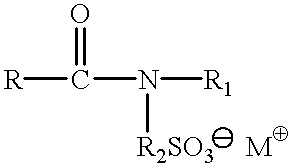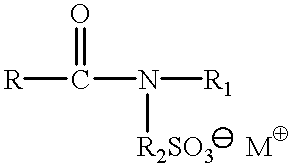Method for cleaning an ink jet print head
a technology of ink jet and print head, applied in printing and other directions, can solve the problem that not all surfactants are as effective in cleaning
- Summary
- Abstract
- Description
- Claims
- Application Information
AI Technical Summary
Problems solved by technology
Method used
Image
Examples
example 1--
Cleaning Experiment on Teflon.RTM. AF Test Surface Using Surfactants 1-3
An adhesion-promoting layer of 1H,1H,2H-perfluorodecyltriethoxysilane (PFDT) (Lancaster Co.) was deposited on a silicon wafer by spin coating in the following manner: A 5% solution of PFDT in Fluorad.RTM. FC-75 fluorocarbon surfactant (3M Corp.) was pipetted on a silicon wafer and spun at 5,000 RPM for 40 seconds. The coating was then baked at 110.degree. C. for 10 min., resulting in a 140 nm thick coating.
A 6% solution of Teflon.RTM. AF (DuPont Corp.) was prepared in perfluorinated solvent C5-18 (DuPont Corp.) and spin coated onto the PFDT coated wafer at 2,800 RPM and then baked for 35 min following a temperature ramp from 50.degree. C. to 330.degree. C. The thickness of the Teflon.RTM. AF layer was 360 nm thick. (A Teflon.RTM. AF surface is representative of a hydrophobic anti-wetting coating that is applied to an ink jet nozzle plate to limit spreading of ink on the nozzle plate.) The Teflon.RTM. AF coated w...
example 2--
Cleaning Experiment on Ink Jet Nozzle Plate
An ink jet print head nozzle plate was coated with Teflon.RTM. AF (300 nm thick) as in Example 1 and subjected to the ink-fouling and subsequent cleaning procedure of Example 1 using Surfactants 1 and 2. The results are listed in the following Table:
The above results show that the cleaning test on an actual ink jet nozzle plate correlates well with the test surface of Example 1.
example 3--
Cleaning Test with Different Concentrations of Surfactant 1
PUM
 Login to View More
Login to View More Abstract
Description
Claims
Application Information
 Login to View More
Login to View More - R&D
- Intellectual Property
- Life Sciences
- Materials
- Tech Scout
- Unparalleled Data Quality
- Higher Quality Content
- 60% Fewer Hallucinations
Browse by: Latest US Patents, China's latest patents, Technical Efficacy Thesaurus, Application Domain, Technology Topic, Popular Technical Reports.
© 2025 PatSnap. All rights reserved.Legal|Privacy policy|Modern Slavery Act Transparency Statement|Sitemap|About US| Contact US: help@patsnap.com


